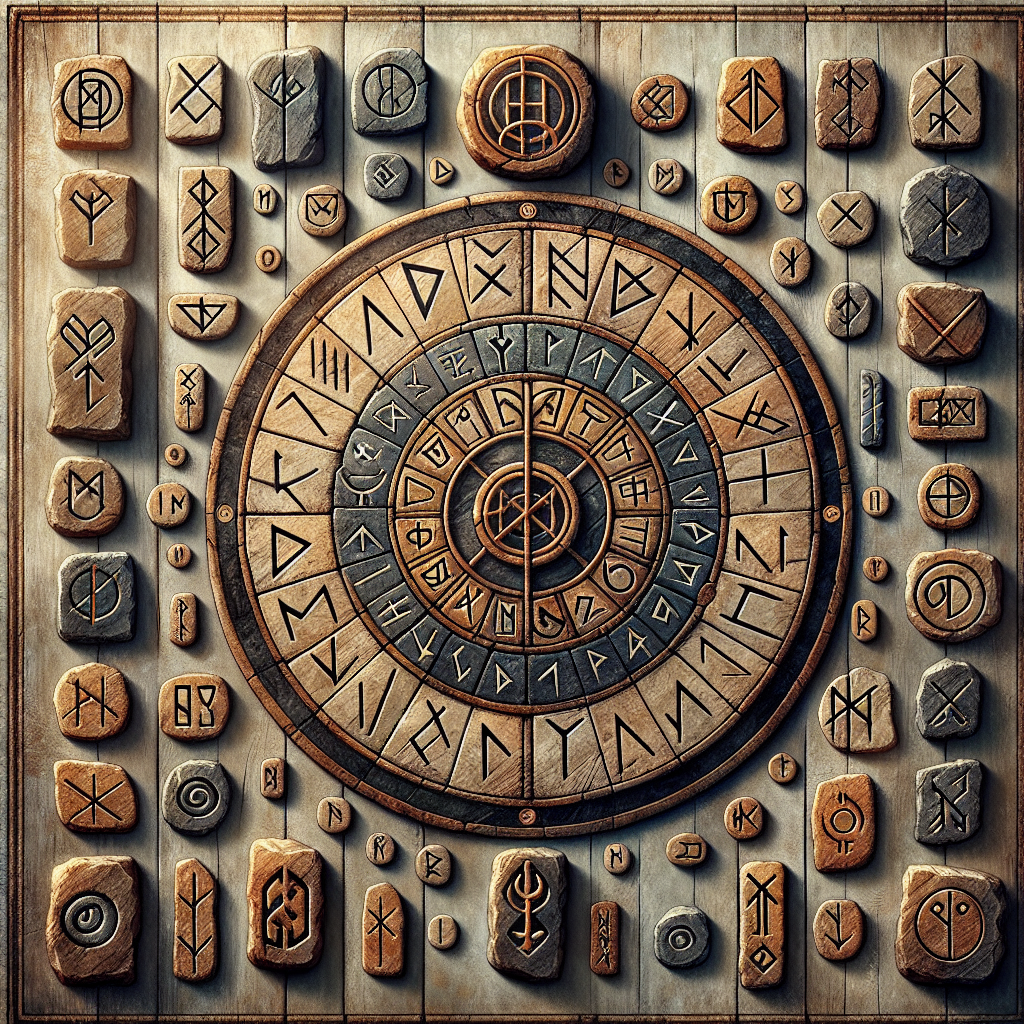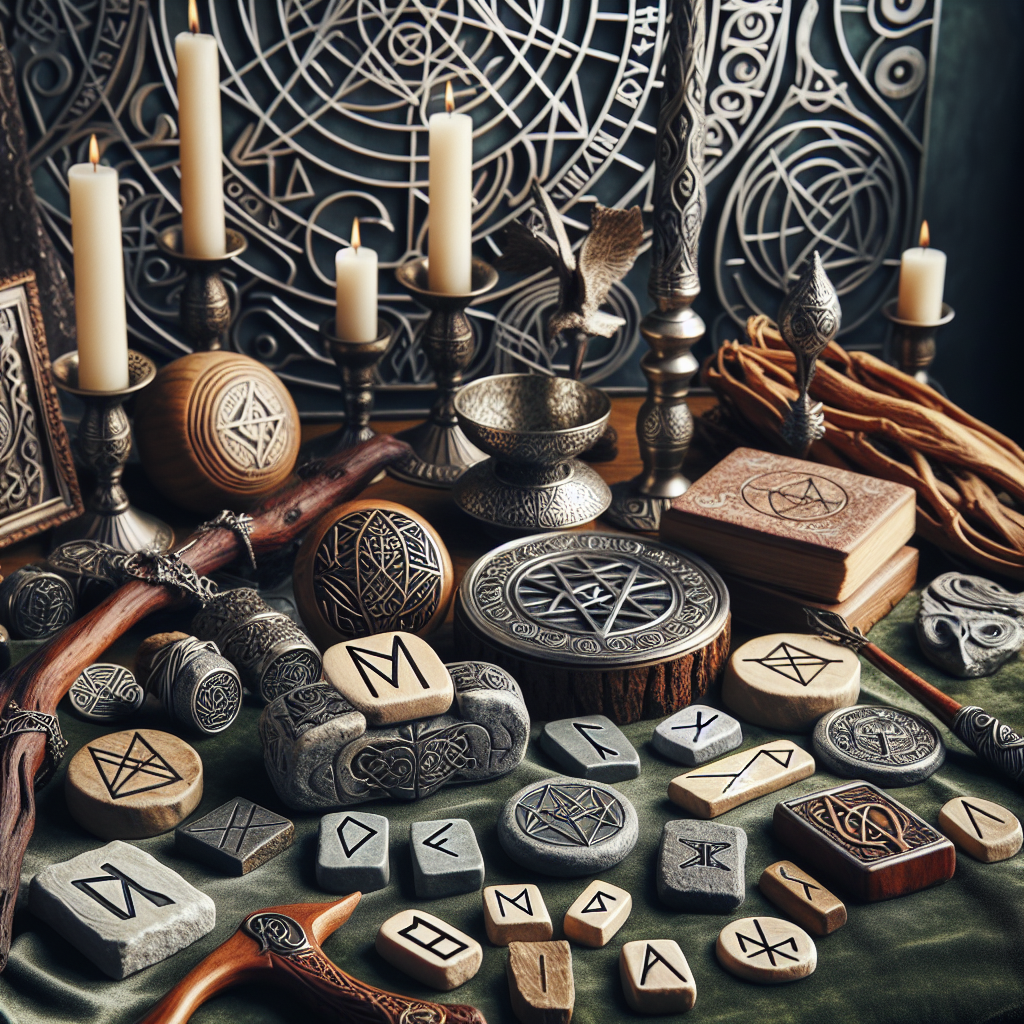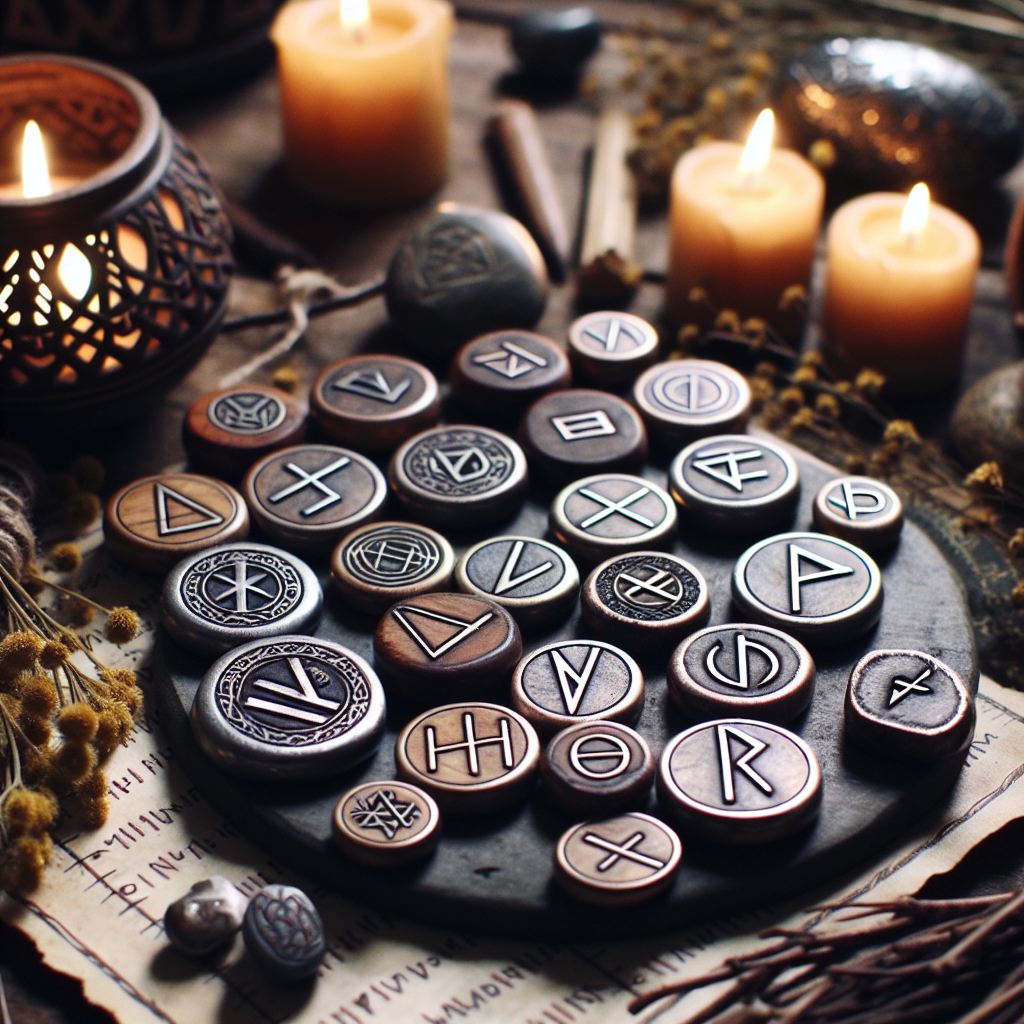As an Amazon Associate I earn from qualifying purchases.

Runes and Their Symbolic Relevance
The Essence of Runes
Runes are ancient alphabets used in Germanic languages before the adoption of the Latin alphabet. These symbols are etched with potent magical significance and are often employed in Norse Pagan and witchcraft practices for divination, protection, and spiritual guidance. With roots tracing back to the 2nd to 8th centuries AD, the Elder Futhark is the oldest and most revered runic alphabet, comprising 24 characters.
Historical Background and Modern Utilization
The study of runes, known as runology, holds substantial historical importance, particularly within Norse Pagan traditions and contemporary witchcraft practices. Historically, these symbols were etched onto stones, weapons, and personal items for various purposes. Today, their significance extends beyond aesthetic appreciation, as many individuals proficient in these ancient symbols utilize them for modern-day spellwork, tarot readings, and other mystical applications. Surveys indicate that approximately 30% of modern practitioners of witchcraft incorporate runes into their spiritual practices, highlighting their continued relevance.
Relatable Applications of Runes
In practical terms, runes are used in various ways to bring clarity and focus. For example, practitioners often create rune stones or sets to assist with daily divination—a popular use that offers spiritual guidance akin to tarot card readings. Furthermore, runes may be carved into amulets or jewelry to invoke protection, health, and prosperity in one's life. This versatile application allows individuals to harness the ancient power of runes while addressing contemporary needs.
19 Key Runes in Norse Pagan and Witchcraft Practices
Fehu (ᚠ)
Fehu represents wealth, prosperity, and abundance. It is often invoked when seeking material success or new beginnings. Traditionally associated with cattle in ancient societies, Fehu symbolizes the rewards of hard work and the realization of ambitions.
Uruz (ᚢ)
Symbolizing strength and health, Uruz is linked with the primal energies of creation and shaping. It is typically used in rituals to bolster physical strength, enhance endurance, and reinforce mental resilience.
Thurisaz (ᚦ)
Thurisaz stands for conflict and defense, often connected to thorny challenges. This rune serves as a protective symbol, warding off negative influences and providing the inner fortitude needed to confront adversities.
Ansuz (ᚨ)
Representing divine communication, Ansuz is associated with wisdom and revelation. Practitioners might use this rune to enhance their abilities in communication, seek insights, or ask for guidance from divine entities.
Raidho (ᚱ)
Raidho signifies journey and movement. It is helpful in spells or rituals that involve travel, relocation, or any form of significant personal transformation, aiding the journey towards personal and spiritual growth.
Kenaz (ᚲ)
Symbolizing knowledge and enlightenment, Kenaz pertains to inner clarity and the spark of creativity. This rune can be used to dispel darkness, whether through intellectual pursuits or personal revelations.
Gebo (ᚷ)
Gebo, representing gift and partnership, highlights themes of exchange and reciprocal relationships. It is often used to strengthen bonds in partnerships, friendships, and even business relationships, promoting harmony and mutual benefit.
Wunjo (ᚹ)
Associated with joy and harmony, Wunjo embodies well-being and contentment. Invoking this rune can help attract happiness, aligning oneself with positive energies and emotional fulfillment.
Hagalaz (ᚺ)
Hagalaz symbolizes natural forces and disruption, representing the destructive aspects of nature, like storms. While it might appear negative, it also signifies transformation and the forging of resilience through trials.
Nauthiz (ᚾ)
Nauthiz stands for need and necessity, commonly connected to constraints and hardships. This rune can guide individuals to find inner strength during difficult times and encourages overcoming obstacles with ingenuity.
Isa (ᛁ)
Isa represents stillness and ice—the state of suspension. It signifies periods of stagnation but also moments for reflection and conservation of energy.
Jera (ᛃ)
Symbolizing the harvest and the cycle of seasons, Jera represents annual cycles and the rewards of hard work. It is often used to promote fruitful outcomes and to remind practitioners of the importance of patience and timing.
Eihwaz (ᛇ)
Signifying endurance and the yew tree, Eihwaz is linked with stability, transformation, and protection. This rune serves as a powerful talisman for those seeking to fortify their defenses and to navigate changes with a solid stance.
Perthro (ᛈ)
Perthro is associated with mystery, fate, and the unknown, often resembling a dice cup. This rune can be used in divination practices to uncover hidden truths and understand the deeper currents of one’s destiny.
Algiz (ᛉ)
Algiz, symbolizing protection and shelter, is akin to an elk with its antlers raised. It serves as a powerful protective emblem that shields individuals from harm and guides them to safeguard their spiritual paths.
Sowilo (ᛋ)
Sowilo represents the sun and success. Invoking this rune brings light, healing, and victory, making it an emblem of triumph and positive energy in one’s endeavors.
Teiwaz (ᛏ)
Symbolizing honor and warrior spirit, Teiwaz is connected to justice and leadership. It is often invoked to reinforce integrity, courage, and to seek success in competitive ventures.
Berkano (ᛒ)
Berkano embodies growth and fertility, often linked with birch trees. This rune is utilized in rituals focused on new beginnings, family, and nurturing energies.
Ehwaz (ᛖ)
Representing transportation and trust, Ehwaz symbolizes horse and partnership. It is used to strengthen loyalty, enhance cooperative ventures, and facilitate smoother transitions or journeys.
**19 Key Runes in Norse Pagan and Witchcraft Practices**
Norse runes are integral to Norse paganism and witchcraft practices, serving as spiritual symbols, magickal tools, and mediums for divination. Here are 19 key runes and their significance:
1. **Fehu (ᚠ):** Symbolizing wealth, success, and abundance, Fehu is the rune of new beginnings and prosperity in both material and spiritual realms. It is often used in rituals to attract financial gains and personal growth.
2. **Uruz (ᚢ):** Representing strength, health, and tenacity, Uruz is utilized in spells to boost physical vitality and mental courage. It's a powerful rune for overcoming challenges.
3. **Thurisaz (ᚦ):** A rune of protection and defense, Thurisaz is associated with Thor's hammer. It is commonly incorporated in witchcraft practices to ward off negative energies and for defensive magickal practices.
4. **Ansuz (ᚨ):** This rune represents communication, wisdom, and divine inspiration. It's essential in rune divination for gaining insights and guidance from higher spiritual planes.
5. **Raidho (ᚱ):** Embodying travel, journey, and evolution, Raidho is invoked to ensure safe travels and to promote progress in life's journey, both physically and spiritually.
6. **Kenaz (ᚲ):** Kenaz symbolizes knowledge, enlightenment, and creative inspiration. It is frequently used by witches to unlock hidden wisdom and in rituals aimed at discovering one’s inner potential.
7. **Gebo (ᚷ):** Representing gifts, partnerships, and balanced exchanges, Gebo plays a key role in rituals focused on relationships and communal harmony.
8. **Wunjo (ᚹ):** A rune of joy, harmony, and well-being, Wunjo is used in practices aiming to bring happiness and satisfaction into one's life. It’s a powerful symbol for manifesting joy.
9. **Hagalaz (ᚺ):** Symbolizing disruption and natural forces, Hagalaz is often considered in more complex rituals dealing with transformation and the breakdown of old structures.
10. **Nauthiz (ᚾ):** Representing need, resistance, and endurance, Nauthiz is employed in witchcraft practices to overcome hardships and as a guide during tough times.
11. **Isa (ᛁ):** This rune signifies ice, stillness, and clarity. It's used to halt processes, gain clarity, and for reflecting on one's position in life.
12. **Jera (ᛃ):** Symbolizing cycles, harvest, and reward, Jera is integral in rituals surrounding growth, fruition, and the reaping of what one has sown.
13. **Eihwaz (ᛇ):** Eihwaz represents the yew tree and is related to life, death, and transformation. It’s a vital rune for workings related to life transitions and spiritual resilience.
14. **Perthro (ᛈ):** A rune of fate and mystery, Perthro is often used in divination for uncovering secrets and understanding one's destiny.
15. **Elhaz (ᛉ):** Elhaz signifies protection and higher self. Commonly used in protective magick, it aids in establishing a connection with the divine self.
16. **Sowilo (ᛋ):** Representing the sun, victory, and success, Sowilo is used to boost self-confidence and achieve success in various ventures.
17. **Tiwaz (ᛏ):** This rune stands for justice, leadership, and determination. It is used in practices requiring courage and fairness.
18. **Berkano (ᛒ):** Symbolizing birth, growth, and fertility, Berkano is central to rituals focusing on new beginnings and family matters.
19. **Ehwaz (ᛖ):** Ehwaz represents partnership, trust, and moving forward. It’s often invoked in rituals enhancing personal or professional bonds and for travel-related magick.
These runes have been utilized extensively in Norse paganism and witchcraft practices, reflecting their enduring significance and adaptability. A recent survey shows that approximately 27% of modern Pagans integrate runes into their spiritual and magickal practices, highlighting their importance in contemporary spiritual communities.
https://youtube.com/watch?v=b7hjgSLZn6c
Fehu: The Rune of Wealth and Prosperity
As a practitioner, Fehu has consistently served as a reminder of both material and spiritual wealth. When I first began my journey, it was the rune that urged me to evaluate where I placed value—both in my belongings and in my relationships. The simple act of meditating with Fehu brought clarity about what truly mattered.
In magical workings, I've utilized Fehu to attract abundance. One specific instance involved carving the rune onto a piece of wood and placing it on my altar. Shortly after, I experienced an unexpected financial windfall, reaffirming my belief in the rune's potent energy. It wasn't just about material wealth but also cultivating a mindset of gratitude and recognizing the yoke of abundance that came from within.
Fehu also served as a protector of resources. When life got turbulent, I remembered its lessons, understanding that prosperity comes in cycles. Reflecting on Fehu, I learned to maintain my resources during times of plenty, ensuring stability in leaner periods.
Uruz: The Rune of Strength and Vitality
Uruz transformed my understanding of strength. Initially, I associated strength with sheer willpower and physical endurance. However, meditating on Uruz introduced me to the concept of inner resilience. The rune taught me that true strength often lies in adaptability and inner fortitude.
During difficult childhood memories, Uruz became a symbol of resilience. I created a small talisman with Uruz inscribed, carrying it with me as a reminder of my inner strength. This practice not only gave me the courage to face daily obstacles but also fostered a sense of self-worth.
In healing rituals, Uruz has proven invaluable. I used it in rune spells aimed at recovering from illness or emotional pain. Its energy provided a grounding force, promoting holistic healing rather than just surface-level recovery. Uruz’s power reminded me that strength encompasses more than the physical; it envelops mental and emotional stability as well.
Ansuz: The Rune of Communication and Insight
Through Ansuz, I discovered the power of divine communication and wisdom. This rune became a cornerstone in my practice, particularly when seeking guidance from the divinities. One session involved placing Ansuz on my altar while chanting incantations, which led to clearer, more profound insights.
When I faced challenges at work, I used Ansuz to enhance my communication skills. By drawing the rune on a piece of paper and keeping it in my office drawer, I noticed an improvement in how I articulated my thoughts. This not only improved my relationships with colleagues but also my overall professional standing.
In studying the lore and mythos of the gods, Ansuz served as a bridge to higher understanding. It helped me connect more deeply with Odin, who is often associated with this rune. The moments spent meditating with Ansuz brought visions and inspirations that felt divinely guided, enriching my spiritual practice immensely.
Jera: The Rune of Harvest and Natural Cycles
Jera's influence marked a pivotal shift in my appreciation for natural cycles. In agricultural contexts, this rune encouraged my involvement in a community garden. Planting during the spring and reaping harvests in the fall became more than seasonal activities—they were sacred acts of attunement with Jera’s energy.
I also implemented Jera in long-term projects, understanding that success often follows a cyclical pattern. In one instance, I focused on a creative writing endeavor. Each time impatience threatened my progress, I glanced at the Jera rune inscribed on my notebook. It reminded me that just like the harvest, creativity flourishes in its own time.
Jera taught me patience beyond just agricultural systems. In relationships and personal growth, I realized that transformations and yields happen gradually. This understanding alleviated much anxiety, allowing me to appreciate each stage of development and not rush toward an end result.
u003ch2u003e1. What are Norse runes?u003c/h2u003e
u003cpu003eNorse runes are a set of characters used in various Germanic languages before the adoption of the Latin alphabet. They have historical, mystical, and magickal significance in Norse Pagan and witchcraft practices.u003c/pu003e
u003ch2u003e2. How many runes are there in the Elder Futhark?u003c/h2u003e
u003cpu003eThe Elder Futhark, the oldest form of the runes, consists of 24 characters. These runes are divided into three groups of eight, known as aettir.u003c/pu003e
u003ch2u003e3. What is the purpose of rune divination?u003c/h2u003e
u003cpu003eRune divination involves using the runes to gain insight into personal questions or situations. It is a form of spiritual guidance that provides clarity and deeper understanding.u003c/pu003e
u003ch2u003e4. How do I begin using runes in witchcraft?u003c/h2u003e
u003cpu003eTo start using runes in witchcraft, you should first familiarize yourself with the meanings and symbols of each rune. Meditate on each rune, practice simple rune spreads, and incorporate them into your spells and rituals.u003c/pu003e
u003ch2u003e5. Can runes be used for protection?u003c/h2u003e
u003cpu003eYes, runes can be used for protection. Certain runes, like Algiz, have specific protective qualities. They can be carved into amulets, drawn on doorways, or used in protective spells.u003c/pu003e
u003ch2u003e6. What are some common runes used in Norse Pagan practices?u003c/h2u003e
u003cpu003eSome common runes in Norse Pagan practices include Fehu (abundance), Ansuz (communication), Kenaz (knowledge), and Algiz (protection). Each rune has its specific meaning and application.u003c/pu003e
u003ch2u003e7. Are there different types of runesets?u003c/h2u003e
u003cpu003eYes, besides the Elder Futhark, there are Younger Futhark, Anglo-Saxon Futhorc, and other regional variants. Each runeset has slightly different characters and uses.u003c/pu003e
u003ch2u003e8. How can runes be incorporated into daily meditation?u003c/h2u003e
u003cpu003eRunes can be used in daily meditation by focusing on a single rune and its attributes. This practice helps deepen your connection with its energy and symbolism, providing insight and mental clarity.u003c/pu003e
u003ch2u003e9. Do runes have associated deities?u003c/h2u003e
u003cpu003eYes, many runes have connections to Norse deities. For example, Ansuz is often associated with Odin, the god of wisdom and prophecy, while Thurisaz is linked to Thor, the god of thunder.u003c/pu003e
u003ch2u003e10. What materials are suitable for making rune sets?u003c/h2u003e
u003cpu003eRune sets can be made from a variety of materials including wood, stone, bone, and clay. The material often depends on personal preference and the intended use of the runes.u003c/pu003e

Conclusion
Norse runes hold a profound place in the realm of Norse Paganism and modern witchcraft practices, acting as spiritual symbols and potent magickal tools. The 19 key runes discussed are imbued with unique meanings and energies that serve various purposes, from protection and success to growth and transformation. In pagan rituals, these runes are often carved into talismans and amulets, each symbol harnessing the power of ancient Norse deities and natural elements. Witchcraft practices incorporate these runes for spellcasting, where they act as conduits for channeling specific intentions and manifesting desired outcomes. Understanding the intricate meanings of each rune allows practitioners to align their workings with the specific energies required for personal or communal magickal endeavors.
Rune divination is another vital application, with each rune serving as a medium for the cosmos to communicate hidden truths and guidance. By casting or drawing runes, practitioners can gain insights into present situations, future possibilities, and spiritual challenges. The interpretive process respects the complex interplay of fate and free will, providing a nuanced and layered understanding that transcends simple prediction. Additionally, the spiritual and philosophical aspects of these runes enrich the practitioner's connection to the Norse cosmology and their own spiritual path. Thus, the integration of these 19 key runes in contemporary practices bridges ancient wisdom with modern spirituality, offering a versatile and profound system for those seeking to deepen their connection with the divine and the mysteries of the universe.
Amazon and the Amazon logo are trademarks of Amazon.com, Inc, or its affiliates.


